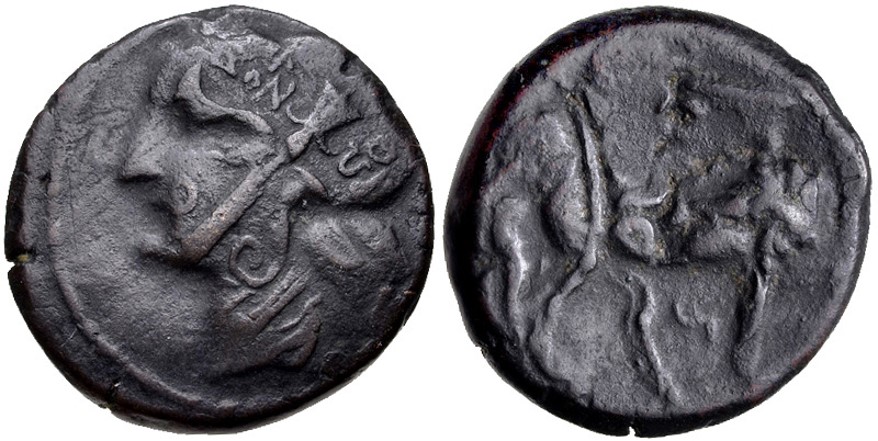3549 - Carthage (AE Tanit/horse) over Syracuse (Poseidon/trident) (CNG, EA 378, 13 July 2016, 80)
From SILVER
215 BCE - 201 BCE
Images
Overstriking coin

Carthage_over_Syracuse_CNG, _EA_378, _13_July_2016, _80.jpg [1]
Location/history
| Sale(s)Sale(s) ᵖ: | Classical Numismatic Group, EA 378, 13 July 2016, 80 | |
| Private collection(s)Private collection(s) ᵖ: | J.-P. Righetti collection |
Overstriking coin
Description
| ObverseInscription or printing placed on the obverse.: | Head of Tanit left, wearing wreath. Border of dots. | ReverseInscription or printing placed on the reverse.: | Horse right, head left. In field, uncertain Punic letter. |
Mint and issuing power
| MintIdentifies the place of manufacture or issue of a numismatic object.: | Carthage | Ancient regionAncient region. | Zeugitana | Modern countryModern country: Tunisia | AuthorityIdentifies the issuing power. The authority can be "pretended" when the name or the portrait of X is on the coin but he/she was not the issuing power. It can also be "uncertain" when there is no mention of X on the coin but he/she was the issuing power according to the historical sources: | Carthaginian Empire |
Chronology
| FromIdentifies the initial date in a range assigned in a numismatic context. 215 BCE toIdentifies the final date in a range assigned in a numismatic context.. 201 BCE | Hellenistic 323-30 BC |
Physical description
| MetalThe physical material (usually metal) from which an object is made.: Bronze |
WeightWeight of the numismatic object (in grams). in grams: 5.995.99 g <br />5,990 mg <br /> | DenominationTerm indicating the value of a numismatic object. Examples: tetradrachm, chalkous, denarius.: Shekel | AxisDescribes the directional relationship between the obverse and reverse of a numismatic object.: 99 mm <br />0.9 cm <br /> |
| DiameterDescribes diameter of an object (in mm).: 1919 mm <br />1.9 cm <br /> | |||
References
| Coin referenceReference of the Coin: | Kapossy 1993, n° 21 | Coin series referenceReference to coin series study: | Kapossy 19931Kapossy 1993, n° 21, Alexandropoulos 20072Alexandropoulos 2007, n° 90 |
| Coin series web referenceCoin series web references: | |||
Overstruck type
Description
| ObverseInscription or printing placed on the obverse.: | Head of Poseidon right (visible on reverse). | ReverseInscription or printing placed on the reverse.: | ΣΥΡΑΚΟΣΙΩΝ (Greek) Trident (visible on obverse: trident with part of Hieron’s name with the control letters Θ Φ below (control letters not listed in CNS). |
Mint and issuing power
| MintIdentifies the place of manufacture or issue of a numismatic object. ᵖ: | Syracuse | Ancient regionAncient region. ᵖ | Sicily | Modern countryModern country: Italy | AuthorityIdentifies the authority in whose name (explicitly or implicitly) a numismatic object was issued. ᵖ: | Hieron II of Syracuse (tyrant of Syracuse, 270-215 BC) |
Chronology
| FromIdentifies the initial date in a range assigned in a numismatic context. 270 BCE toIdentifies the final date in a range assigned in a numismatic context.. 215 BCE | Hellenistic 323-30 BC |
Physical description
References
| Coin type referenceReference to coin series study ᵖ: | Calciati 19863Calciati 1986, 198 | ||
| Coin series web reference overstruckCoin series web references overstruck: | |||
Additional data
| Frequency of overstrikesFrequency of overstrikes: | rare and spread | Level of confidenceLevel of confidence of the identification: | sure |
| RemarksRemarks: | "Overstruck on a bronze of Hieron II with Poseidon head right/Trident. An interesting overstruck coin that clearly shows the trident with part of Hieron's name with the control letters Θ Φ below (control letters not listed in CNS) on the obverse. On the reverse, the undertype is a head of Poseidon right, not left, which is a very rare variety, only represented by six examples in Calciati/CNS. There are two examples in SNG Copenhagen, 323 and 325, that are also overstruck on a Hieron II bronze, but only the trident is visible on the reverse of those specimens." | ||
References
- ^ Kapossy, Balázs (1993), Münzen der Antike : Katalog der Sammlung Jean-Pierre Righetti im Bernischen Historischen Museum, Bern, 425 p., 208 pl.
- ^ Alexandropoulos, Jacques (2007), Les monnaies de l'Afrique antique (400 av. J.-C.-40 ap. J.-C.), Presses universitaires du Mirail, Toulouse, 507 p., 17 pl.
- ^ Calciati, Romolo (1986), Corpus nummorum siculorum. La monetazione di bronzo/The bronze coinage, vol. 2, Milan, Edizioni G. M.
